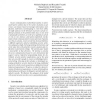42 search results - page 5 / 9 » A Calculus for Cryptographic Protocols: The Spi Calculus |
CCS
2011
ACM
12 years 7 months ago
2011
ACM
We consider security properties of cryptographic protocols that can be modeled using the notion of trace equivalence. The notion of equivalence is crucial when specifying privacy-...
CORR
2011
Springer
12 years 11 months ago
2011
Springer
Consider the problem of verifying security properties of a cryptographic protocol coded in C. We propose an automatic solution that needs neither a pre-existing protocol descripti...
CSFW
2008
IEEE
14 years 2 months ago
2008
IEEE
Secure communication in distributed systems is notoriously hard to achieve due to the variety of attacks an adversary can mount, based on message interception, modification, redi...
FOSSACS
2008
Springer
13 years 9 months ago
2008
Springer
Protocols for information-hiding often use randomized primitives to obfuscate the link between the observables and the information to be protected. The degree of protection provide...
HICSS
2005
IEEE
14 years 1 months ago
2005
IEEE
The goal of a Public-Key-Infrastructure (PKI) is to prove whether a cryptographic public key is authentic for a certain user. This information is crucial for the reliability of as...

